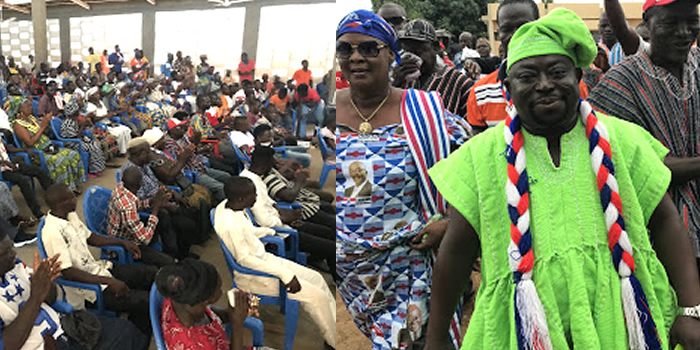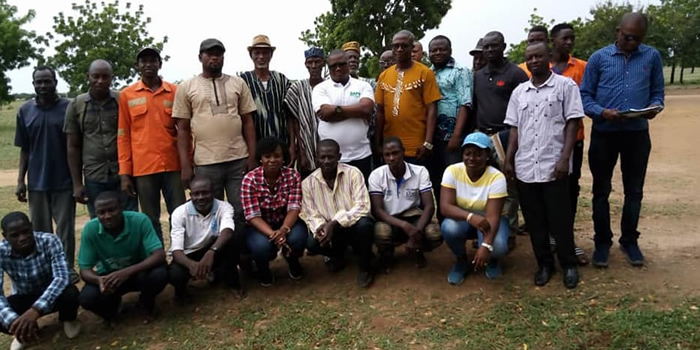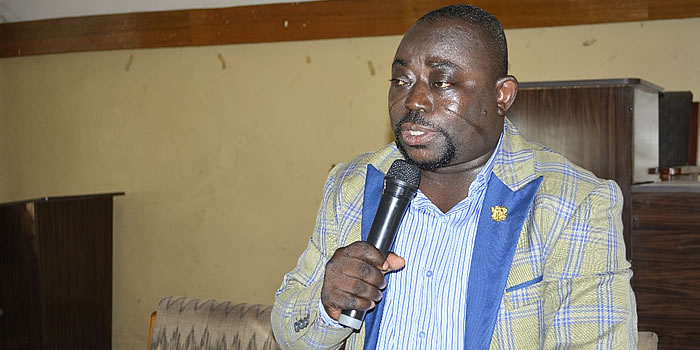

The Bongo District is predominantly rural and it is characterized by large household size, high population density, and high fertility rate as found in other parts of the region.
Growth and Size
The 2000 population and Housing census put the population of the district to 77,885. A calculation by the Planning Team indicated that the District has a growth rate of 2.8%. This put the population of the District at 91, 949 in 2006. Data available in the District shows that there is no significant in-migration of population. It is therefore presumed that the high growth rate is as a result of high birth rate.
Spatial Distribution of population
The settlement pattern of the district exhibits rural characteristics. Apart from the district capital, Bongo, all the other communities are made up of small farm settlements scattered around the district. According to the projected population for 2006, Bongo Township and its environs has a population of about 17,008 which accounts for about 18% of the entire population of the district. Other relatively larger settlements like Namoo, Soe, Zorko- Kanga and Beo exhibit similar characteristics.
Household Size
A household is defined as a group of people living together who share the same catering arrangement. Analysis of the socio-economic survey conducted in the district revealed that the district has an average household size of 9.2 persons. This analysis was also done for all the seven (7) Area councils. The household size for each of the Area Council is found in the table below.
These household sizes are larger than the national standard of 4. This indicates that birth rate in the district is very high. This situation is emphasized by the fact that the family planning acceptance rate in the district is only 18.9%.
Population Density
In 2000, the population density for the district was 169 persons per sq. km. Projections made in 2006 put the population density at 200 persons per sq km. with the land size of 459 sq. km. The trend of increase in population density points to the fact that there is increasing pressure on land for farming and other purposes.
This has been worsened by the fact that people have moved from the widely oncho-infested area of the district and concentrated on less than half of the land area of the district. The situation is more serious since about 40% of the land surface has been covered with rocks which make farming and other activities very difficult.
Thus the land carrying capacity keeps on dwindling with the increase in population. Conscious efforts should be made to reduce the birth rate in the district and develop alternative means of livelihood rather than depending solely on the land for farming which is the main economic activity in the district.
Again conditions at the oncho-free zone can be improve to attract farmers to settle at the place by reducing the nuisance associated with the black flies and also by providing basic social amenities such as potable water.
The table below shows the comparison of population Density with other Districts in Upper East Region. The above table shows that in every eight people in the district, one of them is a child below 5 years. The children of school going age constitute about 44.8% of the entire population
The district has a potential large labour force because the population age 15-64 years constitute about 48%. If this segment of the population especially those who fall within the age (15-39 years) are well managed, it can become a huge economic asset for the district. It is important to note that the size of each of the population segment has implication for demand and planning for future population growth, social services, youth employment, the dependency burden and the overall working force of the district.
Sex Distribution By Age
The table below shows the sex distribution by age The male projected population for 2006 is 42,848 which represents 46.7% of the total population whereas the female projected population is 49,100 representing 53.3% of the entire district population.
The age sex structure for the district is presented pictorially in the population pyramid below. The significant feature about the age sex structure is that the adult age group (20 - 44 years), the female are more than the males. Females in the district form a little over half of the population. This phenomenon is very significant for planning. Consideration of gender issues should also be given prominent attention. Thus, a lot of socio-cultural issues which negatively affect women and girl child in the district should be given a priority.
Dependency Ratio
According to 2000 Population and Housing Census the dependency ratio in the district is 107 which is the highest in the region. This means that every 100 economically active population have the responsibility to cater for 107 dependents. It can further be explained to mean that each economically active person has 1.07 people who depend on him for the livelihood. This has very significant implications, which must be taken into account for development planning.
It must be stated here that age dependency ratio is influenced by birth rate. Population with high birth rate has high age dependency ratio due to the large number of children in the age group (0-14 years). The above issue buttresses the point that serious efforts should be made to reduce the high fertility rate in the district if the district will be successful in its quest to reduce poverty.
Labour Force
According to the Report of the 2000 Population and Housing Census, 66.4% of the active labour force in the district is employed in various sectors of the district economy. This is made up of 67.7 female and 64.7 males. The above shows that females who are employed are more than the males.
The unemployment rate in the district is 26% which is more than twice the National average of 10.4%. It is also higher than the regional average of 20.1%. Bongo District has the second unemployment rate in the region apart from Bawku West which is 27.4%.
The above situation poses a big challenge to the District Assembly and Development partners in the district to put in place concrete programmes and projects to create jobs for the large labour force who are not employed. If this is done, it will help improve the purchasing power of the people, improve their standard of living, and finally reduce poverty in the district.
From the table, agriculture and related activities employed 58.8% of the economically active labour force in the region. More males are engaged in agriculture activities than female. However 35.6% of females are employed in the commerce sector as against 21.4%. This is obvious in the sense that women in the district do buying and selling more than the men.
The picture is also true when it comes to industrial activities. The main industria activities in the district are shea butter extraction, malt processing, Basket and ha weaving and these activities are mostly undertaken by women.
Child Labour/Working Children
Working children or child labour may be defined as children of school going age (7 14) who are engaged in economic activity. This phenomenon is widespread in Bongo District. According to the Report of t! 2000 Population and Housing Census, about 60.3% of children of school going age are engaged in agricultural and related activities. Nearly 29.2% are engaged in industrial activities whiles about 10% are engaged in retail activities. On the whole, about one-third (33%) of the children of school going age are engaged in economic activities in the district.
The settlement pattern of the district is dispersed as in other parts of the Upper East Region. The distribution of services in the district is equally dispersed. However, a lot of services are concentrated in the District Capital Bongo and other major towns such as the sub-district capitals.
Hierarchy Of Settlements
In terms of level or hierarchy of settlements, Bongo (District Capital) is the only first level settlement in the District. In the Scalogram Analysis, Bongo had a total weighted centrality score of 1,500 as compared to the next level with total weighted centrality score of about 230. This indicates that the distribution of functions is highly skewed towards Bongo even though Bongo is not the highly populated area in the district. Most communities in the district fall within the third, fourth and fifth hierarchy levels.
The following have influenced the above situation
- Political/Administrative headquarters (District and Area Council Headquarters).
- Population size (Higher population tend to attract more functions).
- Economic activities in the area e.g. irrigation farming, major marketing centres.
To ensure that facilities in the district are equitably distributed, development programmes could concentrate more in the communities in levels 3, 4 and 5.
Surface Accessibility To Services
Education: In terms of surface accessibility to educational facilities, the district is doing well. However, a few areas such as the Soe area have only one JSS and a lot of communities feed it. There is therefore pressure on the school. There is therefore the need for additional school infrastructure such as a JSS for the area.
The Beo area is also another deprived area in terms of educational infrastructure. The area is normally cut off during the rainy season and therefore children have to risk their lives crossing the streams to attend school in other communities. The provision of school infrastructure would go a long way to help the children from the area.
Environmental Situation
The natural environment consists of fauna and flora in general. These include the trees, vegetation cover and rivers. On the whole, Bongo District falls within the Guinea Savannah ecological zone.
Impact of Human Activities on the Environment
In the past decades, there has been an increase in the amount and intensity of agricultural and other socio-economic activities involving the exploitation of natural resources. This, by its very nature, results in the degradation of the environment. The end result has been to create an adverse effect on the balance between man and nature.
This is also creating an imbalance in natural cycles in the biosphere. Inappropriate farming practices, for instance, have led to increased deterioration in both the vegetation and soils. Intensive faming, overgrazing and constant removal of trees and shrubs without adequate replacement have given way for desert-like conditions in many parts of the district. Owing to increased population growth, there is great pressure on land and water resources. Another practice that is raring its ugly head in the District is farming along river beds, banks of dams and dug-outs thus causing siltation of water bodies in the District.
Wildlife has become threatened as vulnerable tree species die off. These, and many other features, are a manifestation of land degradation, which is a major environmental problem in the district. Land degradation, exhibits itself in three interactive forms: physical, chemical, and biological.
Apart from inappropriate farming practices, land degradation can be attributed to the following factors: high population density, over stocking and overgrazing, bush burning, tree felling, land excavation for road and building construction.
Land degradation is also manifested in soil erosion and loss of organic matter, poor animal production due to reduction in available fodder, siltation of water bodies and loss of aquatic life, trekking long distances to obtain fuel wood by women and increasing intensity and duration of drought.
The over dependence of people on fuel wood and charcoal for both domestic and public use has affected the environment greatly. The few trees available in the district are felled for fuel wood and charcoal for cooking in homes and chop bars.
Soil Erosion
Soil erosion is a major problem in many localities, leading to land degradation. The three forms of erosion experienced in the district are sheet erosion, gully erosion and rill erosion. The long dry season exposes soils to excessive run off at the beginning of the rains. In addition, the low organic matter content of the soils renders the latter liable to sheet erosion.
Gully erosion has affected many river banks as well as roadsides. Gullies of over 3 metres deep and over 4 metres wide are not uncommon. Many of the river banks in the district portray this feature. Rill erosion is Common near the head waters of rivers and streams, where erosion takes place in small, undefined non-permanent excavation, bush burning, removal of vegetation cover, inappropriate farming practices, etc stretches of land bearing scars of excavation can be seen along the major feeder roads in the district.
This situation has grave consequences for the district if not addressed properly. The desert is fast approaching the district considering the enormous felling of trees in the localities. The water bodies are dying out coupled with severe soil erosion. This situation has also escalated the already precarious food shortage in the District.
The district will have to intensify its education on the need to protect the environment especially by planting trees in the localities. The introduction of alternative energy sources could go a long way to curb the intensive felling of trees for fuel wood and charcoal in the District. The intensification of education on the need to adopt modern farming practices is very critical in the district to ensure that the environment is protected.
Environmental Challenges
- Land degradation/Soil Erosion
- Declining soil fertility
- Deforestation
- Reduction in Land Carrying Capacity
- Desertification
- towns and electoral areas
- » TOWNS
» Bongo
» Soe Soboko
» Gowrie-Tingre
» Zoko Tarongo
» Lungu
» Dua
» Namoo
» Zoko-Kodorogo
» Bongo-Nyariga
» Zoko Kanga
» Adaboya
» Bogorogo
» Gowrie Nayire Central Zoko-Gambrongo-Azaabisi
» Zoko-Gambrongo
» Seo-Asabagabisi (Wabisi)
» Vea-Akugrebisi
» Zoko-Goo
» Dua Apuwongo
» Balungu-Gantorisi
» ELECTORAL AREAS
» Bongo-Atampisi
» Bongo-Gobisi (Anafobisi)
» Akunduo (Adaboribisi)
» Gorigu
» Kunkua
» Dua-Yikine
» Apowungo
» Borigo
» Apatanga
» Atampintin
» Namoo-Nabisi
» Akunka-Akumpabisi
» Samboligo-Abokabisi
» Amanga
» Ayopea
» Kansoe
» Boko
» Feo-Akumogbisi
» Sapeeba
» Soe-Tamolga
» Asamwiabisi
» Awokabisi
» Beo-Tankoo
» Dusobligo
» Adaboya
» Gowrie-Agongobisi
» Vea
» Nyariga
» Balungu-doone
» Lungu
» Nayorigu
» Tarongo-Atiabisi
» Gamboringo
» Kanga
» Kodorogo
» Kadare
» Goo
» Awaaj.
Goals and Objectives
The District Medium Term Development Plan under the Growth nd Poverty Reduction Strategy II )2006-2009) comprehensive policies to support growth and poverty reduction over a 3-year period (2006-2009). This falls in line with the government conviction that economy of Ghana needs to be managed effectively and efficiently to enable wealth creation for the benefit of all Ghanaians.
Migration
Migration is an important part of living in the Bongo District. It is a routine activity that occurs during specific times of the year. It is also used for many purposes in the district. Some people in the district see migration as an important coping strategy. They migrate to various destinations within and outside the country in order to find Jobs and earn incomes to meet various needs. All categories of people including women and men, married and singles, youth and middle-aged migrate during the difficult times of the year in order to seek jobs that would earn them incomes.
Women often migrate to the Northern Region during the harvest times in order to render services on farms in return for money and food payment such as corn, millet, guinea corn and ground nuts. Women also, pick sheanuts which, is sold or processed in order to earn incomes to support their families. Men migrate to farming areas in the south such as Kintampo, Ejura, Atebubu, where they render services for cash payment and also obtain corn for their families. Some other people in the district also view migration as adventure especially the male youth.
They travel annually, largely to cities and big towns for adventure. In such town and cities they work in service sectors as potters, meat sellers, cleaners, fufu pounders where they are paid. In resent times, young people migrate to cities and towns in order to experience modern life styles and demonstrate that they have come of age. They want to enjoy the relatively better conditions of the cities and towns such as traveling in trotros and taxis, 24 hours nights, music, potable water, modern toilets, paved streets, beautiful buildings. They want to attend night clubs, eat out and wear fancy cloths and hair styles.
Above all, people in the district view migration as a means to well- being. It has been used as means to the improvement of well being. There is a general perception that through migration people can improve their impoverished situation. They claim that returnees come back home with money and physical resources such as bicycles, boom boxes, clothing, roofing sheets which, enhances their status in the community. There is also the general perception that those living in the communities without migrating could not obtain such items.
In the Bongo District, educational background does not seem to be a major determining factor for migration. Both literate and non literates migrate. Many non-literate youth and adults migrate every year during the off-season period in other to find new occupations elsewhere. Literates who seek alternate work environments, educational Opportunities non-existent in the District also migrate.
Literates are however, more likely to migrate across borders and especially to far away destinations in Europe, Asia and the Americas. Non-literates dominate domestic migration. However, school leavers are likely to migrate. Junior and senior secondary school leavers migrate either to seek permanent jobs or temporary jobs before they continue schooling. Some school going youth migrate down south during the long vacation period to work and return during school time.
Some are unable to return and stay for good. There are cases where some school going youth has been lured to migrate and have been out of school. when all weeding The migration of persons from the Bongo District generally occurs during the off-farm season period- It starts from the end of the raining season when farming activities is slowing down. For the males, it begins is done.
Young males in particular will move away to farming areas in Brong Ahafo and Ashanti Regions, where the raining season is long and farming activities more prolonged, to work on farmlands. At the end of harvest, some migrating females move to the Northern Region while others go to Brong-Ahafo and Ashanti Regions to offer services in crop harvests. This kind of migration is to farming areas and rural areas and is patronized by those who seek foodstuff to support their families.
The main period of migration, however, occurs during the Dry season from October to April, This off farm season period is the peak period where there is massive movement of all categories of persons to various parts of the country and beyond. Migration during the dry season is very high.
The direction of migration in the District is very complex web of multi-dimensional routes. Several routes are used to various destinations or even to one destination. In-Country migration is generally south ward bound through diverse routes. Out-Country migration however, is two-dimensional. Southern and northern bound routes.
Migration Routes
- Southern Route
- Category 1: In - Country i. Bongo - Bolgatanga - Kumasi/Accra Bongo -Bolgatanga - Tamale - Kumasi - Accra
- Category 2: Cross Boarder
- Bongo -Bolgatanga-Kumasi-Takordi-La Cote D’voria Europe/Americas/Asia by water Bongo-Bolgatanga-Techiman/Kintampo/Kumasi-La Cote D’voire Bongo-Bolgatanga-Accra-Aflao-Togo/ Nigeria/ Southern Africa
- Northern Route
- Category 1: Cross Border North Bound
- Bongo-Yelwongo-Ouagadougou/Abidjan ii) Bongo-Yelwongo-Pugu-Ouagadougou
- Category 2: Cross Border East Bound
- Bongo-Bolgatanga-Bawku-Sankasi-Togo
- Bongo-Bolgatanga-Bawku-Garu-Bunkpurugu-Togo
Causes of Migration
Diverse factors and forces are responsible for the migration of people from the District to various destinations. Push Factors The push factors comprise factors within the Bongo District Area that with motivate people to migrate. They include the following.
Date Created : 11/18/2017 6:21:47 AM











 facebook
facebook
 twitter
twitter
 Youtube
Youtube
 +233 593 831 280
+233 593 831 280 0800 430 430
0800 430 430 GPS: GE-231-4383
GPS: GE-231-4383 info@ghanadistricts.com
info@ghanadistricts.com Box GP1044, Accra, Ghana
Box GP1044, Accra, Ghana